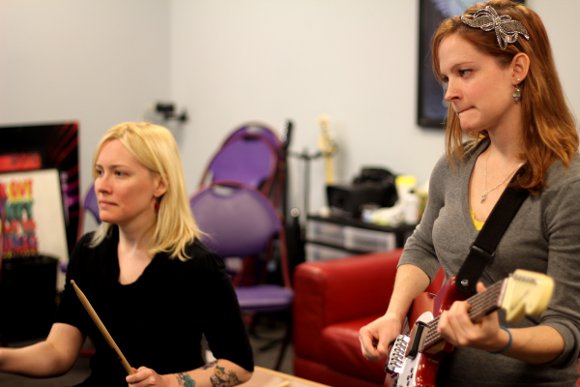
What Harmonix has achieved with Rock Band, and their original Guitar Hero, is remarkable. At their core, these games are descended from arcade rhythm games, reducing music to simple coordination of a few buttons. Yet numerous studies and anecdotal evidence suggest that, in an age in which recording has made musical experience passive for many, the fantasy of holding a plastic instrument is enough to convince people to explore music making again. Rock Band’s collaborative gameplay has people singing and playing again, karaoke style, and more than a few gamers have decided to graduate to real instruments and lessons. Don’t be surprised to walk into a Best Buy and see instruments and pro audio tech in the aisle next to Xbox 360 and PlayStation 3. The genius of Harmonix is that music is again entertainment, not specialization.
What people may not realize is that designing these games is hard. The illusion of simplicity, the experience of fun – these are some of the most daunting challenges in design, period.
So what happens when Rock Band evolves beyond mere rhythm game?
John Drake of Harmonix colorfully sums up the spirit of the new, real-transcription Pro game: “Good luck on that solo, asshole.”
Ramping up the difficulty of a game to real music was a transformative design challenge. We go behind the scenes to hear how Harmonix approached it, what it means for how music works, and what it can mean for your music — or the next time you want to use a game with friends to hone your musical chops.
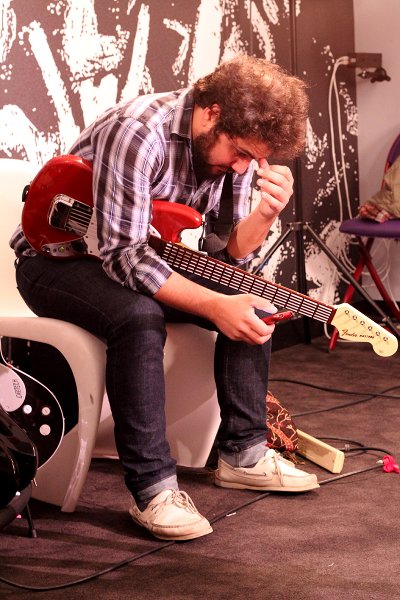
A New Game
Rock Band 3, released today, introduces new instruments and new play modes that blur the line between rhythm game and musical exercise. The hardware inputs are now actual MIDI controllers. A new guitar, the US$150 Fender Mustang Pro, uses around 100 buttons to allow real chord fingering positions – minus the callouses. A new keyboard features two octaves, velocity sensitivity, and touch controls. The guitar and keyboard each have standard MIDI DIN output feature extensive mappings of even the Xbox buttons onboard to MIDI control changes and custom MIDI assignments. A MIDI adapter lets you use your own MIDI hardware. (Ironically, this puts the Mad Catz-built hardware ahead of many supposedly “pro” sub-$100 devices, which now have only USB connections. CDM will have a detailed hands-on with information on how to make use of that MIDI controller in a separate article.)
Accordingly, “Pro Mode” songs feature more extensive transcriptions; learning them is tantamount to simply learning the music. Chords are real chords, and, while reduced to an octave or so, the keyboard parts really are what’s in the song. Needless to say, the presence of a keyboard also opens the floodgates to properly providing keyboard music in the game, from Elton John to John Lennon.
To understand how these changes came about, we have an epic interview with some of the folks at Harmonix. Even if you’re not a music gamer, there’s plenty of reason to pay attention: what they have to say could be relevant to getting your music to a wider audience, and many of the design considerations reveal insights into how people process musical information visually.
And if you are a musician and gamer, you may finally have found a music game you can share with non-musicians without dumbing down your playing.
Speaking to CDM: Daniel Sussman, Rock Band 3 project leader, John Drake, program manager of the Rock Band Network, and Matt “Nord” Nordhaus, senior producer for Rock Band Network. (RBN allows musicians to author their own content for the game and distribute it to players.)
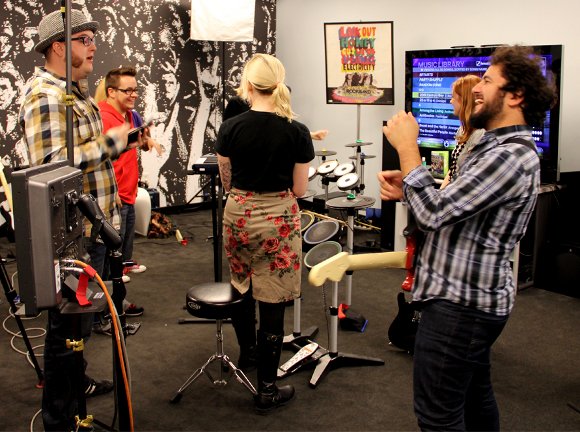
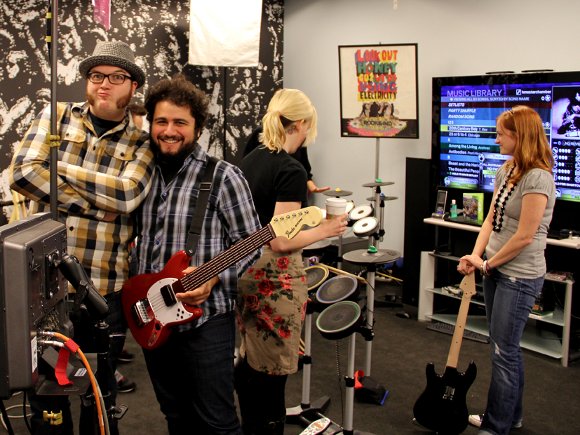
Beyond Rhythm Games
CDM: We know already that your games have turned people on to music, and now it seems Rock Band 3 bridges some of the gulf between game and music. What does that mean for the evolution of Rock Band?
John: From my perspective, it’s certainly opened up a whole new angle to approach people who aren’t rhythm gamers. And as rhythm gamers, people who laugh at Expert guitar charts and say, I can five-star this on a five-button guitar, no problem, like Harmonix are wusses. And I’m like, okay, now you have [Ozzy Osborne’s] Crazy Train on expert, so, good luck on that solo, asshole.
Daniel: Rock Band 3 is welcoming and doesn’t take into consideration any kind of musical background or education. As it relates to a feature set, we really look at making our game musical, but also fun and crazy interactive. What’s unique about the Rock Band Network aspect is that the RBN experience is not really so much a game – it’s more of a pipeline that musicians can use to get their content, their songs into the Rock Band world. If you think about the musical community out there, the ecosystem is really a way into that musical community. You have a game that appeals to a non-musician, they play the game, they have fun, maybe they take a greater interest in music. They use the game to learn how to play guitar or drums, to appreciate music. They start writing their own music, and then put that into the game world for other people to play and interact with.
It’s a kind of funny thing. I don’t think it was totally intentional – the idea that Rock Band would get to the point where you’re able to play the game on controllers that then you can plug into your laptop to make music and then use that same laptop to do all the game authoring and then put that back into Rock Band. That was sort of where we ended up, and it’s great because it all works really well together, but it speaks to the ambition of the studio.
Do you have a sense of what will happen as these new hardware inputs make their way into gamers hands? I guess you have to wait and see.
Daniel: We’re very excited to see what happens. If you read a lot of the statements we’ve made about the ambition for Rock Band Pro, part of it was to draw a deeper connection to the music. Another part of it, really, was to provide a new gameplay experience to an audience of gamers that had been playing the same game for five years on the guitar, or three years on the drums. Really the problem we had to solve was, how can we reinvigorate the category? How can we give these gamers something new to play? And how can we continue to challenge the music gamer in a way that doesn’t just involve the content? Can we build gameplay around something new and unique, and then use that to drive the progression of the franchise?
What’s been interesting is that we get these hardcore gamers who are the cream of the crop in the Rock Band world, they can beat every song on Expert the day it comes out. And then we sit them down with the Pro guitar, and we say, alright hotshot, you probably want to start on easy. I know that’s a novel concept to you know, but try it. And they do, and what happens is, they’re getting like three stars and 60-65% of the notes. And it’s kind of the same experience they had when they first played Guitar Hero 1, or they first tried the drums in Rock Band 1. And that’s really the phenomenal thing here, is that we’ve found a way to reconnect people to all of this great music through the gameplay. And almost as a bonus, the gameplay is totally steeped in actual musical ability, so by playing the game you develop skill that can be applied to things outside the game. But really, that’s secondary, from our standpoint.
What does that mean for play testing and authoring, then, to have these new tiers of difficulty? I know in the past, the first step in authoring was to just do a full transcription of a song, and then try to reduce it to what’s playable on the game controls at different difficulty levels.
Daniel: Well, I think we still start at the Expert authoring level, which is the basic note-for-note transcription of the song. And then as you pare down from there to get to hard, medium, and easy, consider that it’s more like the “campfire” version of the song. On Easy, it’s really root notes of chords on downbeats. It’s more like you’re playing along with the song; you’re not playing exactly what the song is. And then on Medium, we introduce power chords, so you’re playing that root-fifth combination on downbeats. And then on hard, you start playing the full chords, major-minor chords, open chords, and riffs. Expert is everything. We use a lot of the same design strategy as we pare down from expert to easy that we do in the core game, in the core five-lane game.
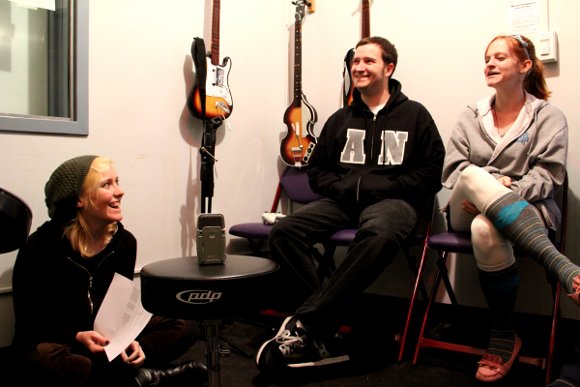
Rock Band’s Place in the Music World
It seems like there’s a strong awareness of what RB3 is doing in the game community, that it is at this new level of musicianship, but maybe not in the music community yet.
Daniel: Our focus really has been on the gamer out there, because we want to make sure the experience is accessible and not intimidating. But we see a lot of potential for an intermediate- to pro-level guitar player or keyboard player who wants to use Rock Band 3 as a way to learn new music, to learn new songs. And I suspect that we’ll get there as the game gets out and people realize what’s going on, the guitars get out and people put it together.
I spoke at a panel earlier this week; it was a panel that was sponsored by NARAS. [That’s the National Academy of Recording Arts and Sciences – yes, the folks who give out the Grammy.] We were talking about digital distribution in this day and age, and how musicians can take advantage of some of the tools. And I was stunned at how few people were aware of RBN, and Rock Band 3. And I still think that in the musical community, music games have this stigma as a game, as a toy. And I don’t think enough musicians out there are as aware of the powerful distribution that’s offered through the Rock Band franchise, and then the actual musical benefits that our game has afforded all the way back. I’m looking for the tide to change within the musical community. I’m in two bands, a lot of people here are very musical people, and deeply, we feel that we want to use the Rock Band platform to promote music and to promote musical experiences, and to encourage people to be musicians. We want to be a part of the musical community, not competing with the musical community in any way.
Have you gotten feedback from musicians as you worked on Rock Band 3, apart from, obviously, the numerous musicians who work for Harmonix?
Daniel: Some. We worked pretty closely with a couple of folks at Berklee College of Music. We’re building this game, we want to make sure that we don’t want to teach people any horrible habits, and all of our chord language is correct, and our fingering is correct, and our ramp is from easy to medium and medium to hard, following loosely with stable, academic doctrine. And so we had a couple of people come in on a weekly basis to play the game. And people were very excited. I think a lot of people have seen the potential of this within the music community. So there are certainly people that are very impressed with what we’ve done and are looking forward to applying it as a tool in the music community.
Do you have hard numbers on the relationship of the game and this game genre to people going out and learning instruments? It seems Rock Band 3 has the potential to make that happen even more.
Daniel: Obviously, it’s too soon to tell what the impact of RB3 will be on, you know, the society that we live in. [laughs] There have been studies, vendors have done studies, Cornell did a study, just on the attach rate between music gamer and how many people play Guitar Hero and then go buy a guitar, how many people play Rock Band and take musical instrument lessons. I know that it’s an interesting topic in the musical academic world. And I think RB3 definitely changes the game. The connection between the game and the actual musical ability is way less tenuous than it has been in previous games. It’s pretty real. I think you’ll see a higher attach rate, but you know, we’ll see.
Some of those hard number… Harmonix provided us with a study, announced in January of 2009, by Fender and non-profit music education organization Little Kids Rock, looking at schools around the United States. The results: educators widely attribute a renewed interest in music education to the games. The study looked at teachers with students in the 8-13-year-old age group.
Results:
67% said guitar enrollment increased as a result of Rock Band and Guitar Hero; 46% bass, and 52% drums. A tiny fraction thought it decreased.
78% said they felt these games had a positive effect.
88% said it had increased interest in classic, guitar-based rock, and a whopping 95% said the two games would help attract new students.
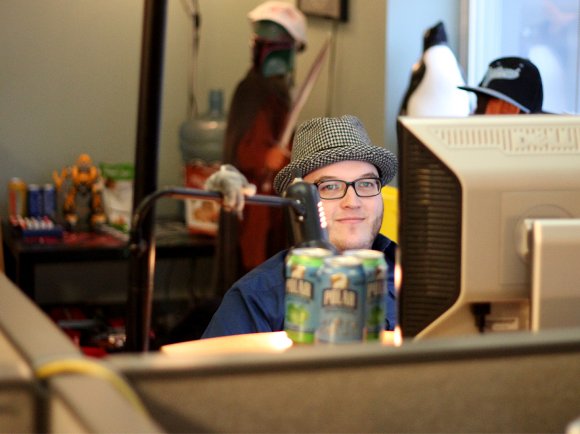

Rock Band Network, Meet Pro Mode, Keys
How are the tools being received in the Rock Band Network community?
Matt: We’re working on the toolset now to add keyboards and harmony to Rock Band Network. The creative community has been incredibly excited about it. I know a lot of them are both holding songs back that have keyboard parts in it, and sort of going after artists who they know might be interested in it. We’ve already had interest from a few major-label artists who have already gotten in touch with us to try to get their stuff in. So I think it’s going to certainly expand the RBN stuff into the keyboard-centric area.
What made the difference for them — is it, okay, now I have an engine that can represent my music, is it that now it’s something that I can take more seriously, or a combination?
Matt: I think it’s more the former. I think these are people who are very keyboard-centric. Billy Joel’s a great example of someone who was added. We’ve had people who said, oh, cool, you have keyboards? I really want to get my songs in there, people who are known for playing keyboards.
John: I think it’s people who make music on that instrument want to see even the representational gameplay. Even if you’re playing keys mode, you don’t have to play the two octaves, we still have that five-button-style gameplay even on the keyboard, I think we’ve always felt a little weird about it when it’s been like, play the organ solo to Smokin’ by Boston on a guitar controller. We did it because it’s an amazing song and we didn’t want to hold it back, but it makes so much more sense, and it’s so much more fun for them to see their music expressed on an instrument, even in a simulation format that’s that much closer to reality. I think it opens the door for them to get excited about it. And then once they’re excited about it, it’s kind of a no-brainer to get their music in.
Of course, as a keyboardist, I’m pleased to see the addition of keyboards; what does that change mean for Harmonix, especially coming from only the guitar and drums?
John: The exciting thing for us is, keyboard is so fundamental in terms of the way that people process and understand music. It’s probably the most linear layout of notes that you can have. It makes a lot of sense to be able to look at a keyboard and be able to understand what that harmonic structure is, versus a guitar. When you see people trying to learn theory from a guitar, they’re able to do it, but it’s a very disconnected and disjointed thing in their minds a lot of the time, if they’re not musicians.
I come from a jazz background. You have great pianists and great piano solos in the context of jazz, but at laest half the time you’re comping. That’s always part of it. It’s such a versatile instrument that can do all those things. I think with Rock Band Network and with Rock Band DLC, what we’re seeing a lot of is the ability to highlight those songs. We’ve got music like Billy Joel, like Imagine by John Lennon, like Bohemian Rhapsody, where the piano has those stand-out moments, where we’re really looking at the keyboardist as featured player. But also we have have songs like Roundabout by Yes, or Freebird by Leonard Skynard, where the keyboard has a standout section or there’s a crazy keyboard solo or sort of insane part, but really it does work as an instrument that’s part of a collaborative effort, which is what Rock Band’s all about. Rock Band’s not about Guitar Heroes, and it’s not about drum solos. It’s about your band playing together. So the keyboard will have its stand-out moments, it’ll cast more light on an instrument that’s often overshadowed.
Matt: The thing about RBN is that you typically see the more the fringe-y, niche-y stuff. It seems likely to be that we’re going to get some of those, like maybe we’ll get a jazz tune where the keyboard comps the whole time. And that would be cool. It’s the sort of thing that we probably wouldn’t release as DLC, because we have more high-profile bands in front of it. But it’s exactly the sort of thing that people put into RBN because they’re passionate about the bands they love and the kind of music they like.
What will the impact of these new levels be on the authoring process? I know you’re working on releasing new tools to work with the new implementations for Rock Band Network; what are you changing?
Matt: We’ve improved a whole bunch of the audition tools to make auditioning much, much quicker and easier — like adding rewind and skip forward, vocal guide pitches and keyboard guide pitches. We actually brought a group of people in, some of the more advanced authors, to check out the MIDI spec, and one of the things they reacted to is that the keyboards are really, really complicated. The difference between five lanes and two octaves doesn’t seem that big, but when you figure out that you’ve got chords and it’s real stuff in real time, it’s a very significant increase in difficulty.
John: Both to author and to play test.
Matt: — and to play. So we’re trying to add some tools to allow them to make sure what they’ve done is correct according to what’s actually in the song.
John: The thing now is that it’s pitch-accurate. So it’s not just charting what feels right; it’s charting what is right.
There’s still compression going on. It’s not the same compression that we do to take all the sonic stuff that you’re hearing down to five colors, but we’re still talking about, if you have a full keyboard part, taking it down to about an octave and a half — you have to think about both the theoretical, what is the best way to do that to make it feel right from a gameplay standpoint, but also how to communicate information so that it’s still pitch-accurate, and it still plays well, with jumping around. When do you leave the bass note in, when do you take the bass note out? It’s a lot of thinking.
It’s not like when we launched originally, when we had four years of guitar authoring under our belts.
So it’s like doing a transcription, in other words — it’s like doing an orchestral transcription for piano, or in this case a piano transcription for toy piano.
John: Yeah, exactly. That’s sort of a funny way to refer to it, but it’s pretty accurate. It’s more an art than a craft.
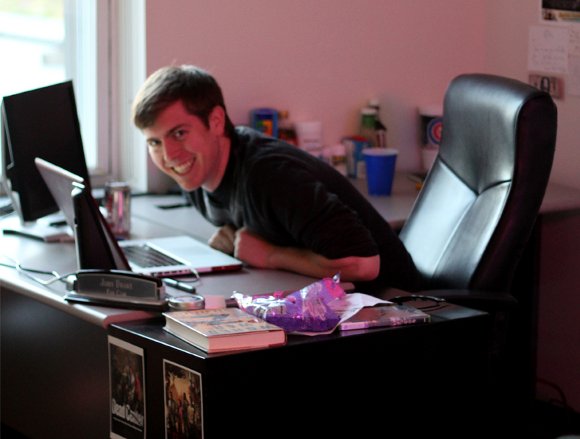
Learning Music with Rock Band
Last week we got to see GarageBand ’11, with additional lessons, and metrics behind those lessons. In a way, the games and the music tools are converging. It seems like what the games are doing can help with learning music.
John: You know, I grew up playing piano. I’m a classically-trained percussionist, and learned piano when I was six years old, and all that good stuff. And the thing that sucks about learning an instrument in isolation is that you play scales, and you play Mary Had a Little Lamb, and you play your A harmonic minor scale. And when you mess up, it sounds bad. And when you do it right, it doesn’t sound that great either. It sounds like a scale.
The fun thing with Rock Band 3 is that the stories we have, we back you with a full band of music all the time. Even when you’re playing your C major scale, or your C major triad, you’re playing it on top of a bluegrass band, or a metal riff. And you feel like you’re accomplishing something. And it makes you want to get over that hump and get over that musical boredom and inertia that holds people down, where they’re not getting engaged on a real instrument. I’m hopeful we get people to feel like they’re learning, to feel like they’re engaging with a game and playing something, and they actually develop some chops and maybe some habits that can get them thinking about musical theory and maybe taking a piano lesson, or reading Keyboard Magazine, or downloading some GarageBand lessons. That’s all good.
It’s like the Jamey Aebersold tapes, where you have a backing track.
John: Exactly. Oh, God, those tapes… I was trained on those tapes. I was trained on… oh, God. They’re good. They’re torture.
So, now we have these full guitars and real two-octave keyboards — was there some iteration to arrive at that solution? I got to poke a little fun at the process when the announcement was made, mocking up a whole staff coming at you in the interface. Maybe at one point there was even something a little like that.
John: God, there was tons of iteration on that. I think this is sort of the genius of Harmonix games. To be very clear. I’m not a UI designer, that’s not my job or my baby, but having seen the iteration process it went through, when you see the end result, when you see the polish, you think, “oh, it must have been a really natural process to come up with this.” But what you’re looking at is hundreds of hours of painstaking thought and work that went into it.
With keyboards specifically, I think the biggest challenge was really getting people who are not used to reading piano roll, and not used to understanding the difference between a fourth and a fifth onscreen, being able to identify that quickly through a seamless UI and jump right in. And I think that our team did a killer job of what’s coming down the display on the screen. I think it’s pretty much the only way you can do it. The idea of having one octave of gameplay at a time, because we tried it with more than one octave.
Matt: And you know, adding the colors. I sat in on all those meetings. I go to all the design meetings. It was fascinating to watch us work through it. We tried not having black and white notes and coloring all the notes, and eventually we ended up on black and white because people are used to that. We struggled with, like, do you light up the lanes when you press them? How thick are the dividers between the lanes? We were tweaking stuff literally until the last day. And it was a nonstop process of iteration through the whole cycle to get it right. It’s very, very hard.
John: And it’s because people are so deep into music here, and want so badly to give people that experience and make it accessible. We can get my mom to play keyboards, and then get a great keyboard player, both being able to sightread something on easy and having a good time, not feeling like they’re reading music and suffering through a rehearsal process.
Matt I think it was a huge debate whether we had a key signature list at the beginning of each song. The keyboard people wanted it, and the design and UI people didn’t want it because they felt it was clutter. We went back and forth on that a bunch of times.
John: At the end of the day, that’s what designing games really is for something like this. If we’re translating a real-world experience, making decisions to give the most amount of information to people without overwhelming them. I think Rock Band Pro really walks that line of filling that screen with all the notes in the keyboard solo in Roundabout, without making you feel like you’re going to have an aneurysm from trying to play them.
My favorite thing is what people said about the pro guitar — that’s been in development as long, if not longer, than keyboards. We’ve been futzing around with that for two-plus years. And playtesting it, people were saying, oh, sure, you can play on it, and it makes sense to you, but you’re a guitar player. And to bring people in who never played guitar before, and give them our tutorial system, to see them like an hour later playing power chords? Playing I Love Rock and Roll? I mean, they’re not mastering it and no one’s playing crazy guitar solos, but to be able to fret three or four chords based on learning it through the game in an hour or two hours. Having them have to stop because their hands hurt — they were grinning from ear to ear, and they were doing it and loving it.
That’s the power of someone learning an instrument and getting excited about it. That’s what we had hoped would happen. The idea that anyone could pick up a guitar and spend two or three hours in our game and walk away knowing two or three chords and how open notes work and how they can move their way around a fretboard — that’s pretty crazy.
That’s the biggest surprise to me — that it fucking works.
It’s why people have been playing music for thousands of years.
All photos: Kyle Mercury. Images courtesy Harmonix.